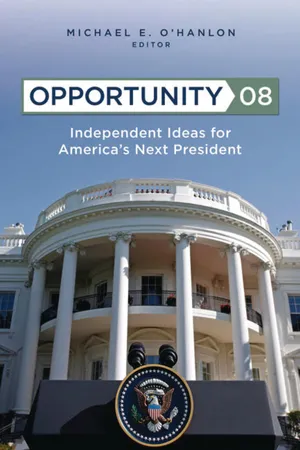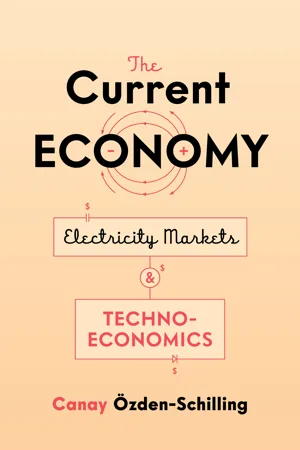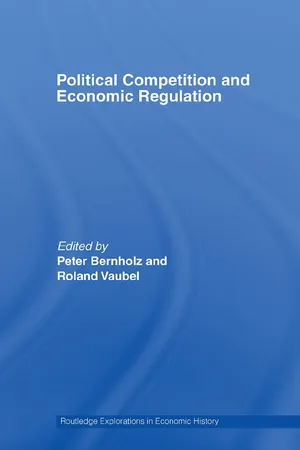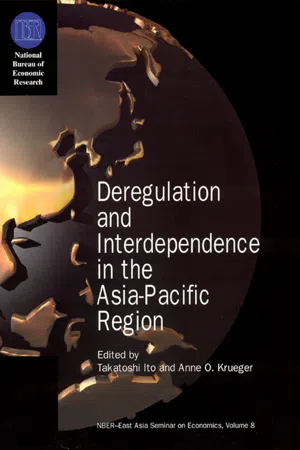Economics
Deregulation of Markets
Deregulation of markets refers to the reduction or removal of government regulations and restrictions on industries and businesses. This is often done to promote competition, increase efficiency, and lower prices for consumers. Deregulation can lead to more innovation and investment in the affected industries, but it can also result in challenges such as market volatility and potential negative impacts on workers and the environment.
Written by Perlego with AI-assistance
Related key terms
1 of 5
5 Key excerpts on "Deregulation of Markets"
- eBook - PDF
Opportunity 08
Independent Ideas for America's Next President
- Michael E. O'Hanlon(Author)
- 2009(Publication Date)
- Brookings Institution Press(Publisher)
CONTEXT Analysts distinguish between economic and social regu-lation. The former is the control of prices, service quality, and entry con-ditions in specific sectors, such as transportation, communications, and energy. The latter is the regulation of risks to health, safety, and the envi-ronment. In this chapter, I focus primarily on economic regulation. Deregulation of major industries in the United States began in the 1970s and spread to the United Kingdom and, to a lesser extent, to the European continent. Despite enormous success, the deregulatory move-ment may be stalled and even subject to reversal in the wake of spectac-ular failure in the perceived “deregulation” of the electricity industry in California, doubts about the wisdom of British electricity and rail priva-tization, the recent surge in oil prices, and debates over access of content providers to new broadband telecommunications services. The next president should act to eliminate many remaining pockets of economic regulation. But a wider assault against myriad forms of inefficient government intervention in markets—beyond classic “regulation”—is more urgently needed. There simply is not much traditional economic regulation left in the United States, outside the telecommunications and electricity sec-tors. However, a great deal of federal interference with the market still occurs, including government control of the electromagnetic spectrum, non-price allocation of water and highways, regulation of airport landing rights, and air traffic control. Moreover, new forms of energy regulation are surely going to be proposed if the price of oil remains above $100 per bar-rel. Reducing these interventions may benefit the economy more than hunt-ing down the last vestiges of traditional economic regulation. The Benefits of Deregulation: Why Markets? Deregulation has greatly improved economic welfare, and the improve-ment builds over time. For example, the U.S. airline industry is still 278 ROBERT W. CRANDALL - eBook - PDF
Competition Law and Economic Regulation
Making and Managing Markets
- Niamh Dunne(Author)
- 2015(Publication Date)
- Cambridge University Press(Publisher)
Regulation is viewed, furthermore, as a self- perpetuating phenomenon 49 – it can lead to even greater amounts of regulation – which, in turn, may perpetuate regulatory failure. Critics of regulation are also quick to compare disfavourably the market outcomes under failed regulation with the presumed superior result in a deregulated and unencumbered market. Public-choice theory is allied closely to Chicago School thinking, which, as discussed, empha- sises the robustness of the market mechanism and its ability to resolve, eventually, almost any market failure. 50 From this standpoint, regulatory failure, whether actual or presumed, may provide justification for market deregulation, meaning the removal of sector-specific regulatory con- straints and obligations such as price controls, entry or exit restrictions or mandatory access requirements. 51 Deregulation may also involve new entry to increase competition, or the disaggregation of functions previ- ously bundled together by a monopoly provider. 52 In its most rudimen- tary form, deregulation implies a total removal of regulatory controls, although, in practice, deregulation is usually a gradual, incremental process. The concept of liberalisation, more specifically, denotes a transi- tion from monopoly to competitive market conditions. 53 Liberalisation is linked directly to the idea of ‘regulation for competition’, that is, the use of regulatory controls to restructure monopoly markets to create com- petitive segments that can, subsequently, be administered through market forces rather than regulatory commands. Particularly in markets that retain natural monopoly or oligopoly elements, initial deregulatory efforts may be partial, with regulatory controls remaining in place at least temporarily for market segments that remain as-yet uncompetitive. The aim of such transitional regulation is generally to move the market 47 Baldwin et al. (2011:70). 48 Sunstein (1990:94–6); Baldwin et al. (2011:71). - eBook - ePub
The Current Economy
Electricity Markets and Techno-Economics
- Canay Özden-Schilling(Author)
- 2021(Publication Date)
- Stanford University Press(Publisher)
I will borrow an example from Ignacio Pérez-Arriaga, one of the characters that this chapter introduces—an expert and master teacher of electricity regulation who served in multiple countries and taught graduate-level courses at MIT for many years. This was one of the many colorful examples to which he liked coming back over the two years of his classes I sat in. Imagine a basketball game between professional athletes and grade school students, Pérez-Arriaga would say to his students. It would make a very unequal playing field; competition would be pointless. The work that you would do for the game to be more competitive—the new rules you would introduce, the existing ones you would change—is regulation. Of course, regulation does not always achieve the intended effect. Let us say, your measure was to simply decrease the time of the game; the pros would, of course, still defeat the grade school students badly. Perhaps a better measure would be to make the pros play with one leg tied behind; that would certainly change the ratio of the score. That, Pérez-Arriaga, would say, is the difference between bad and good regulation.To be sure, the perception of adversity between regulation and markets is not helped by a word like “deregulation”—a word that, in English, implies an elimination of regulation, commonly used to denote the emergence of competition in a previously uncompetitive line of business. Once again, scholars have successfully argued that deregulation as a “system” where “public regulation is abolished and replaced by exclusive reliance on market transactions” is simply an “inaccurate characterization of what is happening [under what is called deregulation]” (Kearney and Merrill 1998, 1324–25). Deregulation might be an unfortunately coined word, but that is no excuse not to study the phenomenon underlying the misnomer. To start on an empirical note, many experts in the electricity industry routinely use the more descriptive word “restructuring” to denote the legal changes in favor of competition that occurred in the 1990s in the US. When they do casually refer to “deregulation” or “regulated vs. deregulated states,” it is rather for the sake of familiarity and not a sign of their perception of markets as uncontrollable beasts. In fact, Pérez-Arriaga once explained to me his interest in teaching regulation for many years by referring to the fact that, since deregulation/restructuring, “regulation has [had] more content.”Recentering our attention in the regulation of deregulation has theoretical value. It offers a way to rethink neoliberalism, a concept that is depicted in anthropology all too often in broad strokes—in a way that misses the technological texture of economic activities rooted in specific work cultures. Scholars often take deregulation, understood as a receding of rules and regulation, to be a telltale sign of neoliberalism—a lawlessness that leads to capitalism run amok (for a critique of this approach, see Özden-Schilling 2018). What this scholarship all too easily forgets is that injustice does not occur only as a result of a lack of rules and regulations—that rules and regulations can be written to sustain the unfairness experienced by subjected parties. I believe, however, that a critique of this broad-stroke application of neoliberalism should not content itself with a mere debunking of the concept of deregulation. Instead, the theoretical ambition of this chapter is to lay down the techno-economic terms of an economic anthropology of regulation—an anthropology that takes regulation as techniques of rulemaking that vary depending on the technologies available to a work culture, as opposed to a proxy concept for government control, fiduciary prerogative, or limitation of competition. The idea is to ask: How did Pérez-Arriaga’s imaginary regulators come up with ideas of decreasing play time or moderately incapacitating the more skilled players? Why did they think a game between these two groups should occur to begin with and should do so in a way that could be regarded as competitive? - eBook - ePub
- Peter Bernholz, Roland Vaubel(Authors)
- 2007(Publication Date)
- Taylor & Francis(Publisher)
The central question of this study is the regulatory leeway which governments retain in the age of globalization. Our empirical study shows that, first of all, the era of globalization is a period of continuing (and converging) deregulation trends with regard to trade, financial and product markets of high-income industrial countries. At the same time, the econometric evidence shows that globalization in the narrow sense of trade openness and capital mobility has a rather limited impact as an immediate driver of deregulation. This means that national divergence from the global trends of deregulation is not clearly linked to the extent to which an economy is integrated in global capital, goods and services markets. Hence, in a narrow definition, globalization as such leaves substantial leeway for specific regulatory approaches of the nation state. However in a wider sense globalization definitions also comprise the easier flow of knowledge and information across borders resulting in more effective cross-border learning processes. The evidence suggests that these learning aspects of globalization are empirically relevant – at least in fields like product and financial markets. Yardstick competition is important: governments commanding instruments of regulatory redistribution cannot ignore deregulation processes beyond their national borders.The notable exception from these insights is labour market regulation. With regard to job protection regulation and the generosity of unemployment benefits, neither deregulation nor convergence can be detected in the covered period. In addition regulatory trends in the labour markets can be explained only poorly by the logic of convergence or cross-border learning. At the same time, government ideologies have a relatively large impact. Furthermore, there is some evidence that labour market regulation increases with more trade openness. These findings do not allow us to discriminate between Rodrik’s compensation hypothesis and Vaubel’s alternative explanation: voters may demand higher levels of job protection and unemployment benefits because more structural change and job market turnover are the necessary outcome of globalization (Rodrik’s view) or because globalization increases structural unemployment in countries with inflexible labour markets (Vaubel’s view). - Takatoshi Ito, Anne O. Krueger, Takatoshi Ito, Anne O. Krueger(Authors)
- 2007(Publication Date)
- University of Chicago Press(Publisher)
Each of the electricity markets that cur- rently exist around the world is the outcome of a deliberate government policy to restructure (and often privatize) the industry. The final form of the electricity industry in United States will be the result of joint decisions by state regulatory commissions and legislatures, as well as market partici- pants. In addition, the Federal Energy Regulatory Commission must also approve all state restructuring plans. As I discuss later, the amount of 82 Frank A. Wolak regulatory oversight in the E&W market has increased since the 1990 re- structuring. The other newly established electricity markets are also sub- ject to significant regulatory oversight. Even the New Zealand electricity supply industry, which touts its “light-handed” approach to regulation, has had a significant amount of government intervention since the market first began operation. All of the plans for establishing electricity markets in the United States mandate continual monitoring of the industry by both state and federal agencies. For all of these reasons, it is more appropriate to think of these restructured industries around the world and the pro- posed markets in the United States as alternative regulatory mechanisms to explicit price regulation for achieving the goals of greater economic efficiency in electricity supply. From the perspective of economic efficiency, the optimal price for elec- tricity should be set to mimic the market price in a competitive industry with many noncolluding firms and minimal barriers to entry. This price has several desirable properties. First, it gives firms the proper signals for the timing and magnitude of new investment expenditures. In addition, because firms have no influence over this market price, they have the maxi- mum incentive to produce their output at minimum cost and can only earn higher profits by cost-reducing innovations not immediately imitated by competitors.
Index pages curate the most relevant extracts from our library of academic textbooks. They’ve been created using an in-house natural language model (NLM), each adding context and meaning to key research topics.




